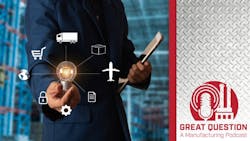Podcast: Has the post-COVID global supply chain become more reliable or less?
Many plants around the world have invested to some degree in Just In Time Manufacturing, where goods are created to meet demand, not created in surplus or in advance of need. However this model was stress-tested in 2020, as the COVID pandemic wreaked havoc on the global supply chain, leading many plants to adopt more of a "just in case" approach to spare parts inventory and beyond.
For this episode of Great Question: A Manufacturing Podcast, we're joined by Jason Manganaro, VP of Commercial Technology for the Americas at SPARX Logistics, who talks with Plant Services chief editor Thomas Wilk about how a post-COVID ripple effect through the global supply chain resulted in innovation at every step.
Below is an excerpt from the podcast:
PS: Jason is headquartered in Columbus. OH, and that's where Jason and I met about two decades ago. Were both in an academic program at Ohio State University. I was in the MA Literature program, he was in the Master of Fine Arts program. Since then, we've taken these winding career paths that have led us to this point where we're talking about heavy industry and supply chains. It’s kind of hard to believe, Jason.
JM: Yes sir, it's interesting how the world works. I always say on the logistics side, I have yet to meet someone in our age group who says “I wanted to be in logistics and I studied logistics and then I got a job in logistics.” It's always “I started off doing X and that led to Y&Z, and then I got a job in logistics and now I've been doing it for 20 years or 30 years.”
PS: It's funny how in my industry, once people take on a certain publication, kind of like you're talking about logistics, you scratch the surface of any industry a little bit, and suddenly you find out there's a whole wealth of information, not only to talk about, but to report on. I had no idea in the world of heavy machinery & asset management, that I'd be working for 9 plus years now, and there's still plenty to say about this topic so I'm assuming the same with logistics on your end.
JM: That's one of the things that I really like about it is, it's fast-paced, it's very interesting, there's always something new, always a new challenge, always a new development. Any time that you feel like things are getting static and steady, get ready because some new turn is around the corner.
PS: Well, usually in these podcasts, Jason, before we tackle the big question, we'll start with a simple one about you and your job. Tell us about yourself and your role with SPARX Logistics and maybe a project or initiative that you've been working on recently.
JM: Sure, as you mentioned, I’m involved with the commercial technology side of things, so I see my role as basically evaluating the technology that we bring into the company for internal use to make us more lean, more optimally set up to handle the challenges of the industry, and then find ways to turn that outward and turn it into solutions for customers. Opportunities to fine tune things that we're doing today, add new capabilities that are that are in demand or that are going to address the challenges that are emerging in the industry and so forth. That's kind of my general role.
You mentioned my background is in marketing, sales, key account management, and creative writing, which sometimes comes in handy when we're trying to figure out how to describe a new service offering or a new solution or something that's a little bit outside of the mold in terms of what we're bringing to the table versus what exists today.
In terms of a specific challenge, one of the things that we're kind of in the middle of now, I would say at the tail end of, is that during COVID we took a hard look at the technology platform that we utilize. The company that I work with, we’ve actually just celebrated our 10 Year anniversary, but there's several of us who worked together in a previous company, so I've got 20-25 years of experience with some of the folks and very happy to have that history and teamwork with my colleagues.
One of the things that came up with SPARX pretty early on was, we wanted to do the same type of freight forwarding and logistics management business, but we wanted to do it a little differently than we'd done with the old company. The old company was more traditional. And we wanted to really put a lot of emphasis on technology and on running a lean organization and really trying to be at the forefront of what's coming next in the industry. From that standpoint, during COVID, we really took a hard look at some of the technology solutions we had, which really I would consider were in that best in class tier of what was available in the industry. But we were thinking about what's next, and what are the things that are going to become more important, and we really dug in and looked at putting some enhancements into the program, and that's the project that we’ve been working on. We're in year three of it, completed phase one and are in phase two right now, to push for staying at the forefront of visibility tools and analytics and ways to take all of the massive amount of data that you collect in the supply chain and make it actionable and the basis for smart decisions by clients.
PS: It sounds like a real familiar story on the asset management side too. I'm sure you've heard this from plant managers, where that's a similar problem they're wrestling with: the vast amounts of data that are now available to collect and draw some actionable insights from. And you've been working in that in that area, in logistics, trying to understand better how all the data that your teams are collecting can help streamline and make more efficient this process of moving things around?
JM: Yeah, absolutely, there's complete alignment in those two areas. There’s so much data available to us. It's not an issue of collecting data at this point. I think it's an issue of sifting through, separating the good clean data from the problematic data – that's been a big part of what we do as well, because just because you have data, it doesn't necessarily mean that it's the kind of data that you can make decisions on. A lot of what we're doing is finding counterpoints to the data to make sure that we can verify the information that we're getting, look at it from different angles and try to come to some source of truth, but it's really to do more with the best possible data point for something that you're trying to determine and then, how do you compare that to what was expected? How do you translate that into cost savings opportunities, efficiency, things that you can really make an impact on your bottom line and on the operation of your plant or your business.
PS: You mentioned a couple of impacts that COVID had on your profession and on your daily workflow. What would you say are one or two lasting changes that we've seen, now having been through that three-year hiccup with COVID?
JM: I think the name of the game for probably almost a decade before COVID was Just In Time fulfillment. You could move goods cheaply, you could purchase them cheaply in other parts of the world, and everyone got in a mode of holding very lean inventory, expecting that, hey, if I need that part, if I'm running low on stock, I can get something here really quickly, really inexpensively, so there's no reason to hold a tremendous amount of spare parts and things like that. But I think COVID really turned that on its ear.
First there was the difficulty of the spread of it, right, and the shutdown of business and transportation and activity in the different countries. Then it was, well, things are opening up, but we don't have any (for example, on the ocean side of things) empty shipping containers to move goods. Then it was well, we can get them there, but once they arrive at destination, there's nobody to offload them or there's a huge backlog of stuff that's already been sitting that hasn't been worked, and now we're piling more containers onto that. Then it was, these warehouses are overrun with the amount of goods that are coming in.
It was a complete rolling imbalance of resources and manpower and capabilities. So I feel like that really turned Just In Time to be part of the past. I don't know that it will never come back, but I feel like we've seen customers really beef up on their safety stock, as things started to somewhat normalize in the last year, year and a half, drawing down all this excess inventory, which threw off their buying patterns and their sourcing patterns.
I think that the biggest part of it looking forward, what we see is really a need to build that agility, that flexibility into your supply chain. There's a lot of ways to achieve that. Diversity of sourcing I think really came into play – that started before the pandemic, that started really with those China tariffs that were driving up some of the cost of sourcing certain goods, the tariffs on steel and aluminum and so forth, people started to look at other places to bring in materials from and started to kind of diversify their sourcing by country, by vendor, things like that.
Coming along with that is a diversity of routings. How do I get the goods from my sourcing country to the U.S.? Are there various ways or various modes? What do I do if this way gets clogged? Do I have a backup? And then of course, my piece is the technology part to have the best visibility, the most fine-tuned visibility on what's in your supply chain, where it is, and at any given point to be able to steer it left or right if things aren't moving along the way that you'd like them to be.
Read the rest of the transcript
Like this episode? Listen to
- "The state of supply chains – What to expect in 2024"
- "How are logistics companies helping plants calculate the carbon cost of their operations?"
- "4 ways Six Sigma can improve your supply chain"
About the Podcast
Great Question: A Manufacturing Podcast offers news and information for the people who make, store and move things and those who manage and maintain the facilities where that work gets done. Manufacturers from chemical producers to automakers to machine shops can listen for critical insights into the technologies, economic conditions and best practices that can influence how to best run facilities to reach operational excellence.
Listen to another episode and subscribe on your favorite podcast app
About the Author

Thomas Wilk
editor in chief
Thomas Wilk joined Plant Services as editor in chief in 2014. Previously, Wilk was content strategist / mobile media manager at Panduit. Prior to Panduit, Tom was lead editor for Battelle Memorial Institute's Environmental Restoration team, and taught business and technical writing at Ohio State University for eight years. Tom holds a BA from the University of Illinois and an MA from Ohio State University
